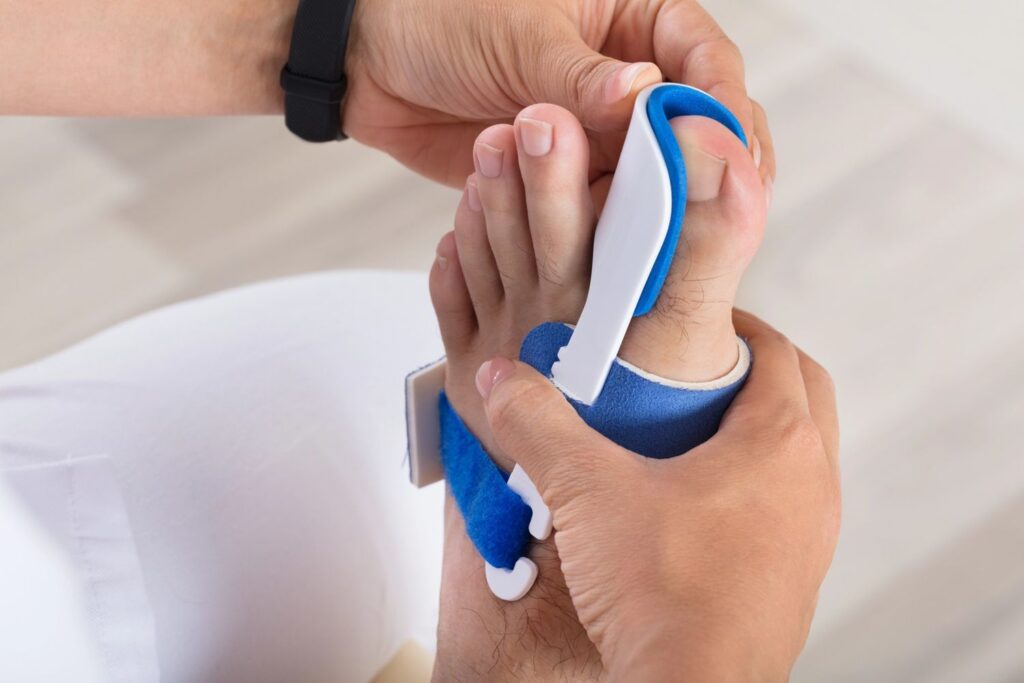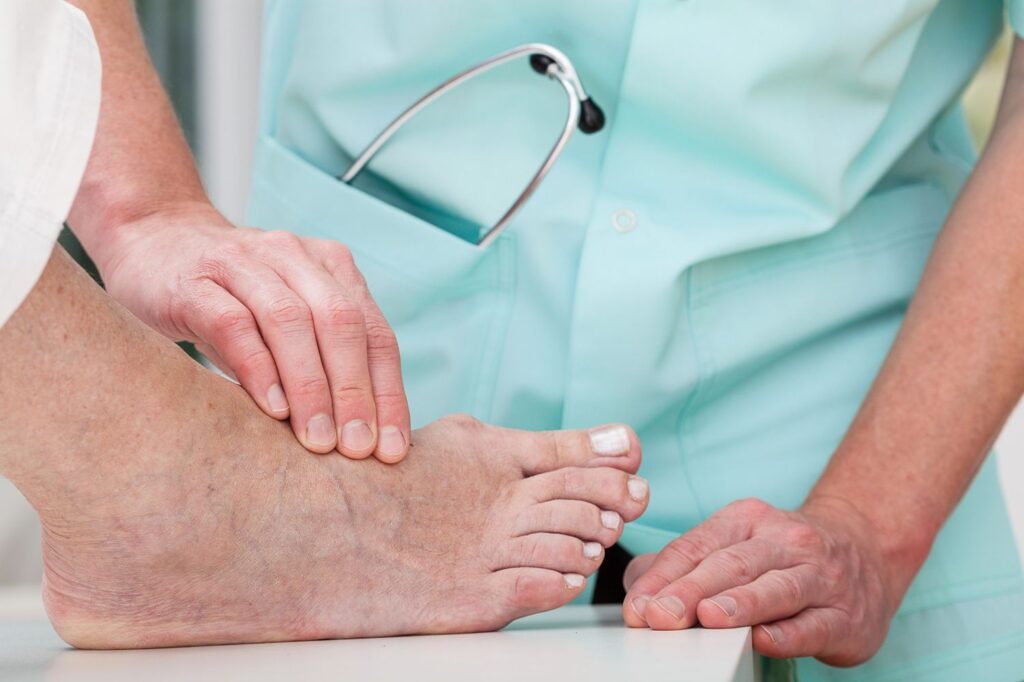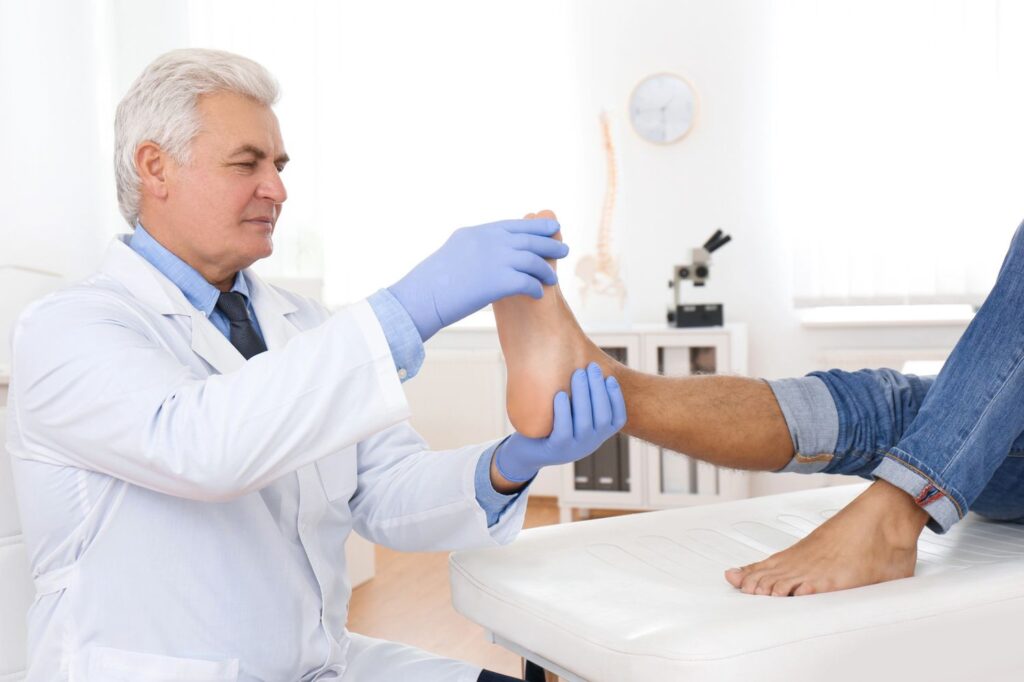Bunions are one of the most common foot problems that cause pain, discomfort, and changes in the shape of the foot over time. Many people assume that once a bunion starts to form, there’s nothing that can be done to stop it, but that’s not entirely true. While bunions don’t go away without surgery, several effective strategies can help prevent them from worsening, relieve pain, and slow their progression.
In this guide, we’ll explore how to stop bunions from growing, including practical prevention tips, lifestyle changes, footwear recommendations, and treatment options available at Vital Podiatry Foot and Ankle Specialist.
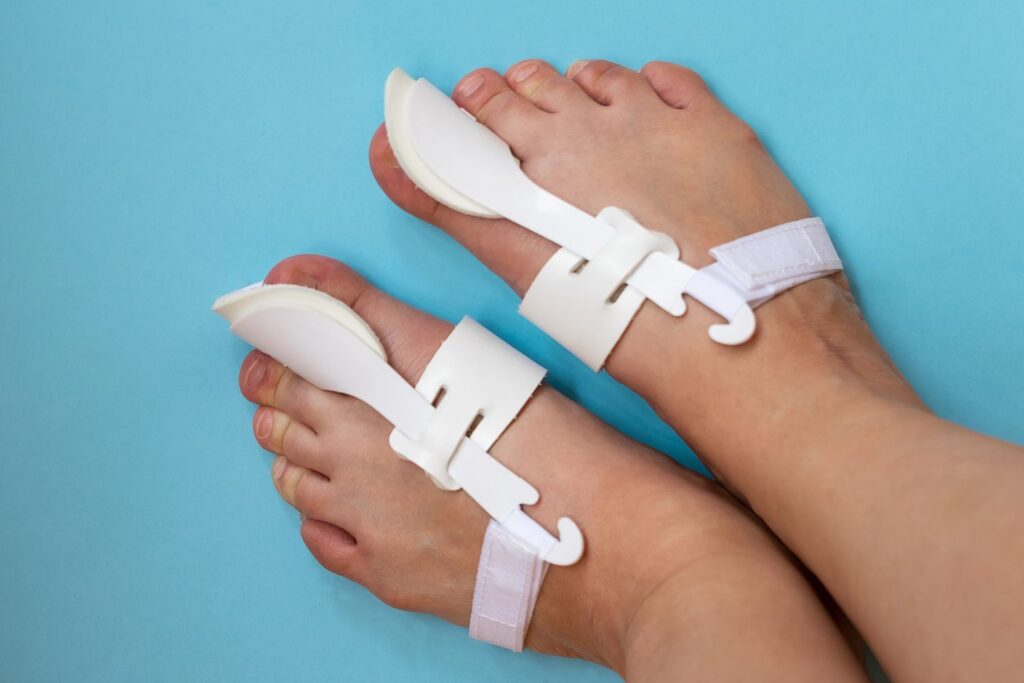
Understanding Bunions: What They Are and Why They Develop
A bunion (hallux valgus) is a bony bump that forms at the base of the big toe. It occurs when the bones in the front of your foot move out of place, causing the tip of the big toe to lean toward the second toe. Over time, this misalignment makes the joint at the base of the big toe stick out, forming a visible bump.
Common Causes of Bunions
Several factors contribute to bunion formation, including:
- Genetics: Bunions often run in families due to inherited foot shapes.
- Improper Footwear: Tight, narrow, or high-heeled shoes force the toes into unnatural positions, putting pressure on the big toe joint.
- Foot Structure: Flat feet, low arches, or abnormal bone alignment can increase bunion risk.
- Medical Conditions: Arthritis, especially inflammatory types like rheumatoid arthritis, can cause bunion development.
- Repetitive Stress: Activities that involve repetitive foot movement or pressure may worsen bunions.
Understanding what causes bunions helps you make informed decisions to prevent them from growing larger or more painful.
Can You Stop a Bunion from Growing?
While bunions can’t shrink on their own, their progression can often be controlled with consistent care and non-surgical measures. The goal is to reduce the pressure and strain on the joint, correct foot alignment, and maintain comfort during daily activities.
Let’s explore practical steps you can take to stop bunions from getting worse.
1. Choose the Right Footwear
Footwear plays a major role in bunion management. Shoes that are too tight or narrow around the toe box can push your big toe inward, worsening the bunion over time.
What to Look for in Proper Shoes
- Wide Toe Box: Allows your toes to spread naturally without friction or pressure.
- Soft Materials: Leather or mesh offers flexibility and reduces irritation.
- Low Heels: High heels shift your body weight forward, putting more stress on your toes.
- Supportive Soles: Cushioned soles help absorb shock and relieve joint pressure.
Pro Tip:
When buying shoes, shop later in the day when your feet are slightly swollen this ensures a better fit.
At Vital Podiatry Foot and Ankle Specialist, we often recommend specific brands or orthotic inserts tailored to your foot structure for optimal support.
2. Use Custom Orthotics or Inserts
Orthotic inserts are one of the most effective ways to relieve pressure from bunions and prevent further misalignment.
How Orthotics Help
- They redistribute pressure across your foot evenly.
- They support your arches, improving overall alignment.
- They stabilize your gait, minimizing strain on the big toe joint.
Custom orthotics are specifically molded to your foot shape, providing superior comfort and support compared to over-the-counter inserts. Many patients at Vital Podiatry Foot and Ankle Specialist have found that orthotics significantly reduce discomfort and slow bunion progression.
3. Maintain a Healthy Weight
Extra body weight adds stress to your feet, especially the joints around the toes and arches. Maintaining a healthy weight can reduce strain on the big toe joint, helping to stop bunions from growing.
Practical Tips
- Engage in low-impact exercises like swimming, cycling, or walking.
- Focus on balanced nutrition to support joint health — foods rich in omega-3 fatty acids, calcium, and vitamin D are beneficial.
- Avoid prolonged standing without supportive footwear.
Even modest weight loss can make a noticeable difference in reducing bunion-related pressure.
4. Stretch and Strengthen Your Feet
Simple foot exercises can improve flexibility, maintain mobility, and strengthen muscles that help keep your toes aligned.
Effective Exercises
- Toe Stretches: Pull your big toe gently away from the others to improve joint mobility.
- Towel Scrunches: Place a towel on the floor and use your toes to pull it toward you — this strengthens your foot muscles.
- Marble Pick-Ups: Pick up small objects with your toes to enhance coordination and strength.
- Toe Circles: Rotate your big toe in small circles to relieve stiffness.
Doing these exercises regularly can reduce tension around the bunion and prevent worsening misalignment.
5. Apply Ice and Use Anti-Inflammatory Measures
Inflammation around the bunion joint can cause pain and swelling. Regularly applying ice packs for 10–15 minutes can help soothe discomfort.
For ongoing inflammation, your podiatrist may recommend:
- Topical anti-inflammatory gels
- Non-steroidal anti-inflammatory drugs (NSAIDs)
- Warm foot soaks with Epsom salt
These methods won’t change the bunion’s shape but will make walking more comfortable and reduce irritation that could accelerate bunion growth.
6. Protect the Bunion with Pads or Splints
Specialized bunion pads, cushions, or night splints help relieve friction between the bunion and your footwear.
Types of Protection
- Gel Pads: Act as a cushion to prevent rubbing.
- Toe Spacers: Separate the big toe from the others to maintain better alignment.
- Night Splints: Keep your toe straight while you sleep, reducing stiffness.
Although these are temporary measures, they’re excellent for pain relief and can reduce the likelihood of worsening deformity.
7. Monitor Your Foot Health Regularly
Bunions progress gradually. Regular check-ups with a podiatrist can help detect subtle changes in bone alignment or joint movement early on.
At Vital Podiatry Foot and Ankle Specialist, we assess the severity of bunions using digital imaging and gait analysis. This allows us to create personalized treatment plans that may include:
- Updated orthotics
- Footwear adjustments
- Physical therapy
- Preventive care education
Monitoring your bunion’s progression ensures timely intervention before the deformity worsens.
8. Avoid Aggravating Activities
Certain habits or activities can make bunions more painful or speed up their growth.
Things to Avoid
- Wearing tight shoes for long hours
- Standing for extended periods without breaks
- High-impact exercises like running on hard surfaces
- Ignoring early pain signals around your big toe joint
Switching to activities that reduce pressure such as elliptical training, swimming, or yoga can help protect your joints and keep the bunion from worsening.
9. When to Consider Medical Treatment
If pain persists despite conservative measures, or if the bunion begins affecting your daily activities, it’s time to consider professional treatment options.
Non-Surgical Options
- Corticosteroid injections for inflammation
- Physical therapy to improve flexibility and posture
- Custom orthotics for advanced support
Surgical Options
While surgery is generally a last resort, some cases require it to realign bones and relieve severe pain. Bunion surgery (bunionectomy) can correct deformities and improve walking comfort, though recovery varies depending on the procedure.
At Vital Podiatry Foot and Ankle Specialist, we help patients understand their options clearly before recommending any surgical intervention.
10. Long-Term Prevention and Foot Care Habits
Even after successful management or surgery, bunion prevention is a lifelong process.
Tips for Ongoing Foot Health
- Rotate shoes often to avoid uneven pressure.
- Check for early signs of discomfort or redness near your big toe joint.
- Continue stretching exercises to maintain flexibility.
- Keep toenails trimmed and clean to avoid secondary irritation.
- Schedule periodic foot evaluations with your podiatrist.
By making small daily changes, you can significantly slow or even stop bunion progression.
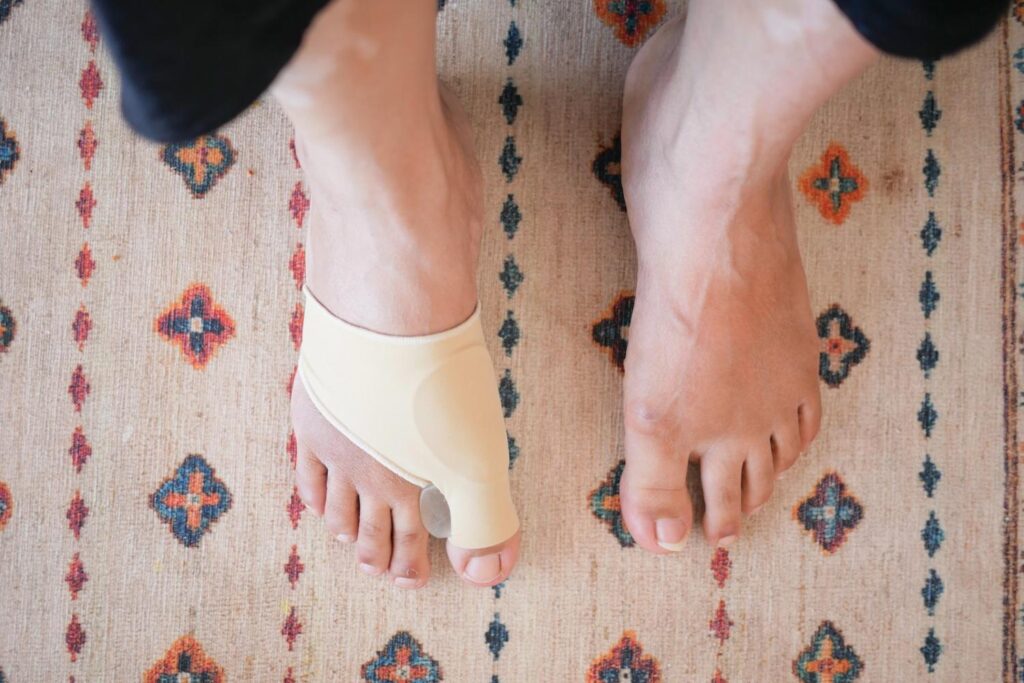
Trusted Bunion Surgery Doctors Near Fountainhead Village at Vital Podiatry Foot and Ankle Specialist
If bunion pain has started slowing you down, you deserve care that helps you get back on your feet comfortably and confidently. At Vital Podiatry Foot and Ankle Specialist, we provide expert bunion surgery and comprehensive foot care for patients near Fountainhead Village, combining advanced medical expertise with a personal touch that prioritizes your comfort, recovery, and long-term results.
Here’s why more patients trust us to help them take the next step toward pain-free living.
1. Experienced and Specialized Bunion Surgeons
Our team of board-certified podiatrists has extensive experience performing bunion correction surgeries and treating a wide range of foot and ankle conditions. We use a combination of modern techniques and evidence-based care to ensure every procedure is precise, effective, and tailored to your unique needs.
Whether you’re struggling with mild discomfort or advanced deformity, our surgeons focus on restoring natural alignment, improving mobility, and reducing pain so you can walk confidently again.
2. Advanced Diagnostic and Surgical Technology
At Vital Podiatry Foot and Ankle Specialist, we invest in cutting-edge diagnostic imaging and minimally invasive surgical tools to achieve the best outcomes possible. Our advanced technology allows us to:
- Accurately assess bunion severity and bone alignment
- Create personalized treatment plans
- Perform surgery with smaller incisions and faster recovery times
By combining precision diagnostics with advanced care techniques, we make sure your surgery is efficient, safe, and designed for long-term success.
3. Personalized Care Plans for Every Patient
No two bunions are exactly alike and neither are our treatment plans. We take time to understand your medical history, lifestyle, and goals before recommending surgery.
Our podiatrists provide:
- Comprehensive consultations
- Pre-surgery guidance
- Post-operative care plans
- Rehabilitation support
This individualized approach ensures that you get the right treatment at the right time, with clear communication every step of the way.
4. Conveniently Located Near Fountainhead Village
Our clinic is easily accessible for residents of Fountainhead Village and nearby areas, making expert podiatric care closer than you think. You don’t have to travel far for top-rated bunion specialists, your trusted team is right in your neighborhood.
From your first consultation to your final follow-up, we’re here to make your experience smooth, supportive, and stress-free.
5. Compassionate Care You Can Count On
We understand how bunion pain affects your daily life from walking comfortably to wearing your favorite shoes. That’s why our approach isn’t just about surgery; it’s about helping you regain your quality of life.
Our team listens, explains your options clearly, and works closely with you to ensure a comfortable recovery. You’re not just a patient here, you’re part of our care family.
6. Faster Recovery, Better Results
Thanks to our advanced surgical techniques and personalized rehabilitation programs, most patients experience faster healing times, less post-surgery discomfort, and improved foot function.
Our goal is to help you get back to walking, working, and enjoying your daily routine without the constant pain that bunions can bring.
7. A Reputation Built on Trust and Results
Patients near Fountainhead Village consistently choose Vital Podiatry Foot and Ankle Specialist for our proven results, compassionate service, and dedication to excellence in foot and ankle care. Our focus on patient satisfaction and successful outcomes has made us a leading name in podiatry care throughout the region.
Take the First Step Toward Pain-Free Living
You don’t have to live with bunion pain any longer. The trusted bunion surgery doctors at Vital Podiatry Foot and Ankle Specialist are ready to help you walk comfortably again.
If you’re in or near Fountainhead Village, schedule your consultation today and discover why patients trust us for expert care, advanced techniques, and lasting relief.
✔ Expert Surgeons
✔ Personalized Treatment Plans
✔ State-of-the-Art Facility
✔ Convenient Location Near Fountainhead Village
Your feet carry you through life — give them the care they deserve.
Contact Vital Podiatry Foot and Ankle Specialist today and take the first confident step toward a pain-free future.
Vital Podiatry Foot and Ankle Specialist Serving the Fountainhead Village Community and Beyond in Houston
Vital Podiatry Foot and Ankle Specialist is dedicated to serving the diverse needs of the local community of Houston, including individuals residing in neighborhoods like Fountainhead Village. With its convenient location near landmarks such as The Northland Christian School and major intersections like San Clement st and San Bernadino St (coordinates: 29.98314,-95.49812), we offer Bunion surgery Doctors services.
Get Bunion Surgery Doctors Services At Fountainhead Village Now
CALL US NOW!
(281) 937-4546
Navigate from Fountainhead Village to Vital Podiatry Foot and Ankle Specialist Now
Final Thoughts
Stopping bunions from growing requires a combination of proper footwear, supportive orthotics, consistent exercises, and regular monitoring. While these steps don’t reverse existing bunions, they can make a significant difference in maintaining comfort and preventing the deformity from getting worse.
At Vital Podiatry Foot and Ankle Specialist, our team provides comprehensive care for bunions from personalized orthotics to advanced treatment plans designed to protect your long-term foot health. With the right approach, you can stay active, pain-free, and confident on your feet for years to come.
FAQs
1. Can bunions stop growing without surgery?
While bunions cannot reverse or disappear without surgery, their growth can be slowed with the right care. Wearing supportive shoes, using custom orthotics, performing foot exercises, and maintaining a healthy weight can all help manage pain and prevent worsening. At Vital Podiatry Foot and Ankle Specialist, we create personalized care plans to help control bunion progression effectively.
2. What type of shoes should I wear to prevent bunions from getting worse?
Choose shoes with a wide toe box, low heels, and good arch support. Avoid narrow, tight, or pointed shoes that force your toes inward. Proper footwear helps relieve pressure on the big toe joint, slowing bunion growth. Our podiatrists near Fountainhead Village can recommend the best footwear and inserts for your specific foot structure.
3. When should I consider bunion surgery?
You may want to consider surgery if conservative treatments like orthotics, padding, or physical therapy no longer relieve pain, or if the bunion is affecting your ability to walk comfortably. At Vital Podiatry Foot and Ankle Specialist, our experienced bunion surgery doctors evaluate your condition carefully to determine if surgical correction is the best option.
4. How do orthotics help with bunions?
Custom orthotics help redistribute pressure across your feet, improve alignment, and reduce strain on the big toe joint. This slows the progression of bunions and eases pain during walking or standing. Our team at Vital Podiatry Foot and Ankle Specialist provides tailored orthotics designed for long-term comfort and correction.
5. How can I keep bunion pain under control at home?
You can manage bunion pain by wearing supportive shoes, applying ice to reduce swelling, using bunion pads or toe spacers, and doing gentle foot exercises to maintain flexibility. Consistent care and regular check-ups at Vital Podiatry Foot and Ankle Specialist ensure that your bunion management plan stays effective and up to date.







